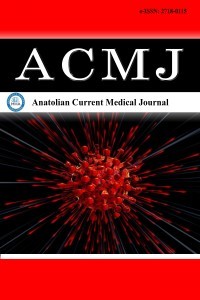
Anatolian Current Medical Journal
Yazarlar: ["Ümit AYGÜN", "Ömer AYIK"]
Konular:-
DOI:10.38053/acmj.1147770
Anahtar Kelimeler:Intertrochanteric femur fracture,Proximal femoral nail,Bipolar hemiarthroplasty,Prognostic factors,Functional outcomes
Özet: Aim: In the treatment of intertrochanteric femur fractures, proximal femoral nail (PFN), and bipolar hemiarthroplasty (BPH) are widely used. This study aimed to compare these two types of implants depending on risk factors regarding patients. Material and Method: PFN (Group 1) was applied to 40 of the 89 patients (44 female, 45 male) aged between 51-80 (mean 68.16±6.78) and BPH (Group 2) was applied to 49 of them. Age, gender, fracture side, fracture mechanism, additional disease, Body mass index (BMI), Albumin level, Hemoglobin (Hb) decrease level, T-score, American Society of Anesthesiologists (ASA) classification, type of anesthesia, surgery type, operation time, hospital stay and full weight-bearing time, Harris Hip Score (HHS) in preoperative and postoperative periods, classification of intertrochanter fracture according to the AO Foundation and Orthopedic Trauma Association (AO/OTA), postoperative complications were recorded. Results: Group 1 was younger with a mean age of 64.55±6.23 years compared to Group 2 (p <0.05). Most of the fractures were 3A2 type and the result of low energy (p>0.05). In group 1, operation time was 46.78±5.29 minutes and hospital stay was 2.48±0.75 days, which was shorter, most surgery types were closed, T-score was -2.49±0.59 and better, the time of full weight-bearing was 3.48±0.78 months, Hb decrease was 1.17±0.37 g/dL and less, Albumin level was 3.11±0.4 g/dL and higher (p<0.05). In Group 2, the age was the highest (72.6±5.2) and the T score was the lowest (-2.9±0.4) in the 3A2 fracture type (p<0.05). HHS was better in the BPH group at the sixth month (p<0.05), and there was no difference between the two groups at the end of one year (p>0.05). Conclusion: Prognostic markers for treatment outcomes in individuals with intertrochanteric fractures are still unknown. It is important to determine the factors that will contribute to the long-term functional results in these patients.